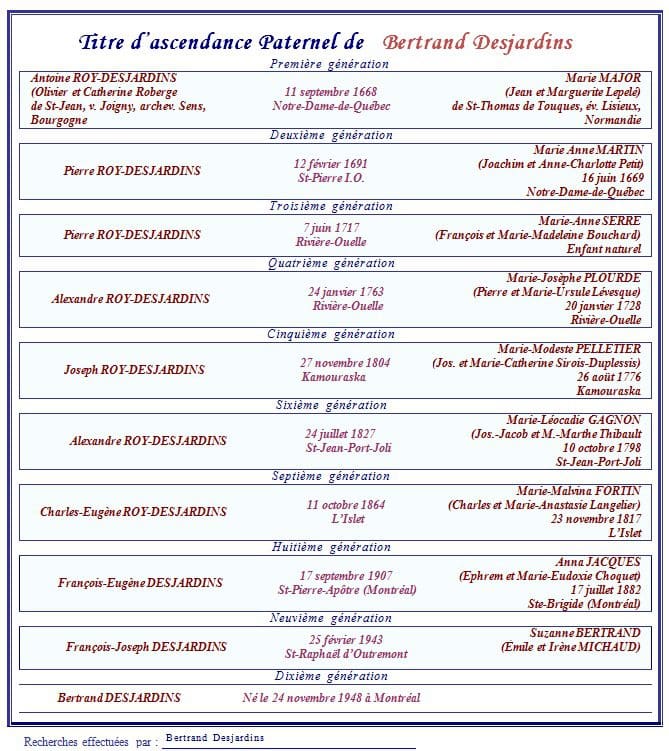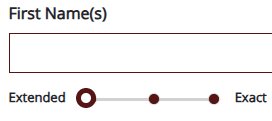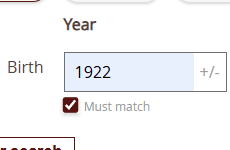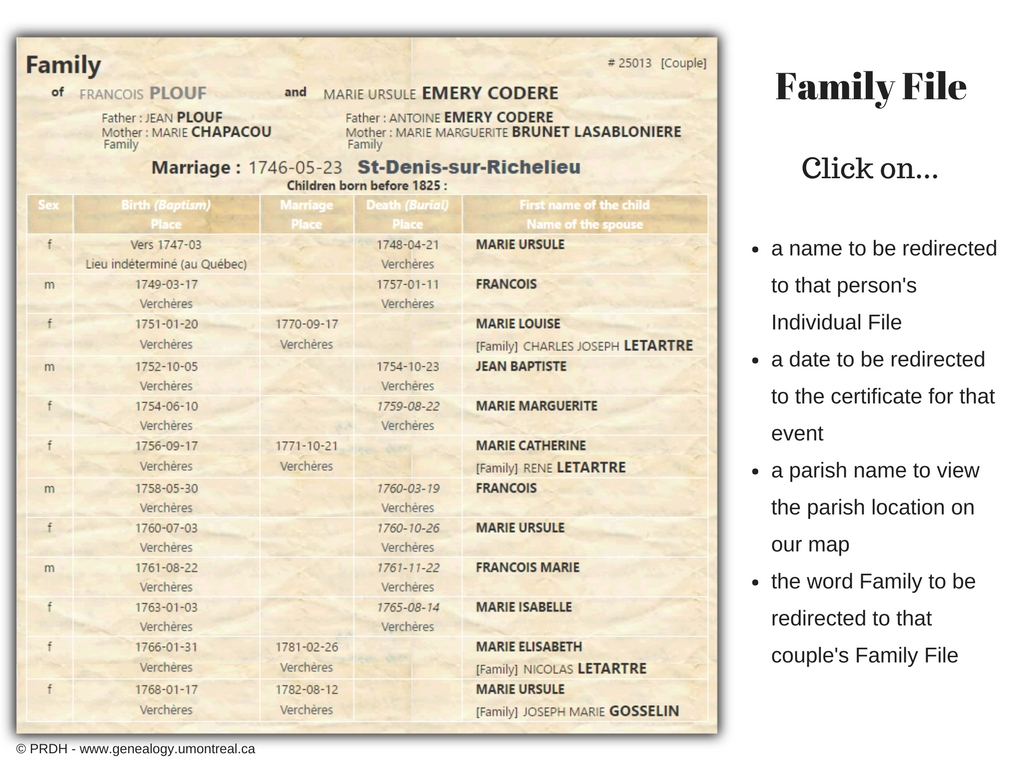
Welcome to Genealogy Quebec!
Whether you’re taking your first steps in genealogy or you’re an experienced researcher discovering our platform, this guide is for you.
If you’re new to genealogy, click here.
If you have genealogy experience but are new to Genealogy Quebec, click here.
The Basics of Genealogy
Genealogy is the science dedicated to researching family lineages. But more specifically, what does this research involve?
It all depends on your goal. In fact, there are several types of genealogy, and the scope of your research will depend on the type of ancestry you wish to build.
Linear ancestry
All the direct-line ancestors of the individual of your choice (generally your father) — their parents, then paternal grandparents, and so on.
This is the simplest and quickest type of ancestry to complete, and it connects you directly to the most distant direct ancestor bearing your family name.

Complete Ancestry

All the ancestors from whom you descend. This type of ancestry includes every known ancestor in your lineage, with the number doubling each generation: two parents, four grandparents, eight great-grandparents, and so on.
Your Genealogical Research in 3 Steps
Whether you’re working on linear or complete ancestry, the key to your research is the marriage record.
Indeed, officiants were generally required to record the names of the spouses’ parents. By finding the marriage records for these individuals, you can trace back to the previous generation, and then repeat the process to go back through the generations.

Step One – Gather Information
To trace your ancestors, the first step is to establish the information you already know — such as names, dates, and places — by speaking with relatives if necessary.

It is strongly recommended to record as much information as possible so you can refer to it during your research.
Step Two – Use This Information to Find a Marriage in the Lineage
It’s now time to use the information gathered in the first step to locate a marriage record in the lineage, which will serve as your starting point.
Step Three – Trace Back Generation by Generation
With a marriage record in hand, you are now in a position to trace the ancestors in your lineage. You can go back one generation by finding the marriage of the groom’s or bride’s parents, whose names are listed in your starting marriage record.
To do this, simply search for the names of the groom’s or bride’s parents, as applicable.
This process is repeated until you reach the first generation of your lineage to set foot in Quebec, often in the 18th or even 17th century. Depending on the family, you may have to go back more than ten generations before reaching the first immigrant.
Additional Documents – The Little History of Your Ancestors
Tracing the individuals in your lineage is the foundation of genealogy. But once these people are identified, is your research over? Once again, it all depends on your goals.
Some researchers set out to find the children of the couples they’ve traced or to supplement the lineage(s) with birth and death dates and locations for each individual. These additional searches are generally done using birth and death records.
However, Genealogy Quebec also offers a wide variety of documents that can add color and depth to your family tree.
On the search engine, you will find the following types of documents:
- Obituaries and memorial cards: May contain additional information about the deceased and their family.
- Headstones: Provide a place of memory and reflection for your ancestors.
- Censuses: Offer a variety of information about the family unit.
- Notarial contracts: Give fascinating insight into various aspects of our ancestors’ daily lives.
- Postcards: Offer a unique glimpse into the everyday life of our ancestors.
- Other miscellaneous documents
You now have all the tools you need to start your genealogical research!
Want to go further? Check out our complete 7-part genealogy guide, which explores each step of the process in detail and supports you throughout your discoveries:
- Lesson 1 – Introduction to Quebec Genealogy
- Lesson 2 – Starting Your Genealogy Journey
- Lesson 3+ (Coming Soon)
Researching on Genealogy Quebec
Whether you’re searching for a specific document, an individual, a lineage, or a complete genealogy, Genealogy Quebec’s search engine has got you covered.
The search engine is divided into two sections that operate independently, each with its own features: Basic Search and Advanced Search.
By default, Basic Search is enabled. You can activate Advanced Search by clicking the Advanced Search button.

Basic Search
Basic Search, with its 4 fields, works on a simple principle: you are searching for a specific individual, and the search engine provides you with every document on the site that mentions the individual. The results are ordered according to the probability that the document in question relates to the individual you’re looking for.
The more the information contained in a document matches your search parameters, the earlier it will appear in the results list.
First name(s) and last name(s)
This is where you enter the name of the person you’re looking for. This person can have any role in the document (subject, parent, spouse, godparent, or simply being mentioned anywhere within the document), but documents where the person is the subject are prioritized.
Accents, capital letters and hyphens may or may not be used in your search without affecting the results.
Adjusting the search broadness
Under the first name and last name, you have the option of adjusting the broadness of your search, i.e. the level of difference between the name you entered, and the name found in the corresponding document.
There are three levels to this option:
- Exact search
- Similar search
- Extended search

The different search levels are explained at this address.
Year of birth
In the year of birth box, it is important to enter the exact or approximate year of birth, not the year of marriage or death.

The engine performs a calculation based on the year of birth to show you results relevant to your search. If you enter a date other than the approximate year of birth, many relevant records will be excluded from the search results.
You can adjust the range of years searched by clicking on +/-.
Location where your ancestor may have resided
The location is used to order and prioritize search results. For example, if two documents contain the name entered, but only one contains the location searched for, the document also containing the matched location will appear first in the results.
You can use the location search box freely, by entering a district, town, region, parish or even a country.
Please note that a match between the searched location and the location listed in the document is not necessary for the document to appear in the search results. The location is only used to prioritize results, not to exclude them.
Advanced Search
Advanced Search allows you to refine your search using additional parameters. It consists of two parts: adding events and adding individuals (coming soon).
Add an Event to the Search
This feature allows you to specify the date and/or location of events related to the individual or document you are searching for.
Available Events
- Birth: Add the year and place of birth or baptism for the person you are searching for.
- Marriage: Add the year and place of marriage for the person you are searching for.
- Death: Add the year and place of death or burial for the person you are searching for.
- Residence: Add the year and place of residence for the person you are searching for.
- Publication: Add the year and place of publication, prioritizing documents published at that date and/or in that place.
- Any Event: Search for a year and/or place appearing in a document, regardless of the event to which that date or place is associated. The year and place entered do not need to belong to the same event.
When you add an event year or location to your search parameters, the search engine uses it to rank the results by relevance. The more closely a document matches your search criteria, the higher it will appear in the results list.

However, you can require a parameter to be present by using the “Must Match” checkbox. When this box is checked, only documents in which this information is explicitly mentioned will appear in your search results.
Search filters
The search engine offers filters that allow you to refine your search results.

Three filters are available: filter by document type and source collection, filter by location, and filter by date.
When you apply a filter, any documents that do not match it are removed from the results list.
For more information about the search engine and usage tips, please refer to our Search Engine User Guide.
Other Tools and Collections
Finally, Genealogy Quebec offers directories of parish registers and various documents, accessible through structured folder trees:
- Drouin Collection Records: All parish registers from Quebec and French Acadia, as well as some from Ontario and the Northeastern United States, dating from 1621 to the 1940s.
- Drouin Miscellaneous Collections: An assortment of archival fonds, images, documents, books, photos, and directories of historical and genealogical interest.
- City Directories: Various city directories and phone books from across Quebec and Ontario, often dating back to the 19th century.
Although these sources are less accessible than the collections integrated into the search engine, they remain extremely valuable and can greatly assist your research.
Finally, feel free to contact us at contact@institutdrouin.com with any questions about the site or genealogy.
Happy researching!





































































































